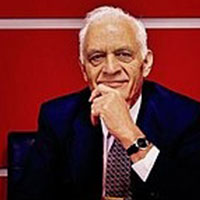Amar Bose
Amar Gopal Bose was an Bengali-American entrepreneur and academic. An electrical engineer and sound engineer, he was a professor at the Massachusetts Institute of Technology for over 45 years. He was also the founder and chairman of Bose Corporation.
The brilliant mind behind the founding of the Bose Corporation, a name which spells supreme quality in the fields of acoustics and sound systems, Amar Bose was a visionary much ahead of his time.
Bose was born in Philadelphia, Pennsylvania, to a Bengali Hindu father, Noni Gopal Bose and an American mother of French and German ancestry, Charlotte. His father was an Indian freedom revolutionary who, having been imprisoned for his political activities, fled Bengal in the 1920s in order to avoid further persecution by the British colonial police. His mother, Charlotte, is described as an American schoolteacher of French and German ancestry, but Bose described her as “more Bengali than I”. She was a vegetarian and deeply interested in Vedanta and Hindu philosophy.
Bose started displaying his astute mind and entrepreneurial skills from a young age. Electronics intrigued him even as a child and he spent hours dismantling and fixing radio sets. Little did he know how handy his skills would be during the war times! At the time of World War II, when his father’s business was not doing too well, young Amar offered to help his father with his own business venture. Daily after school he would repair radios and contribute to his family’s income. Recognizing his son’s talents,his father borrowed $10, 000 in 1947 and sent his son to the prestigious Massachusetts Institute of Technology (MIT). He was meant to study in the MIT for two years, but ended up staying there for nine months during the course of which he completed his BS. Bose spent a year at Philips Natuurkundig Laboratorium in Eindhoven, Netherlands; and a year as a Fulbright research student in New Delhi, India, where he met his future first wife. He earned his PhD in Electrical Engineering for his thesis on non-linear systems.
A lover of classical music, he bought an expensive stereo system which was theoretically supposed to produce high quality sound. However on using it he found that it produced very inferior sound, a realization that motivated him to research on the topic. Upon his graduation he became an Assistant Professor in MIT though he was equally interested in research. He went on to teach at MIT for 45 years. During the early 1960s, he invented a new type of stereo speaker which made use of multiple smaller speakers. His PhD mentor at MIT, Dr. Y. W. Lee motivated him to pursue long term research in acoustics. Thus in 1964, he founded his own company, the Bose Corporation that specializes in audio equipment.B ose was striving to create the next generation of speakers. By 1968, he introduced the 901 Direct/Reflecting speaker system which helped to establish him as the market leader in the audio components market. He continued his pioneering research in this field and invented the Bose Wave radio and the Bose noise-cancelling headphones. These inventions were so successful that they were adopted by pilots in both the military and commercial sectors.
Bose was very passionate about research and designed a software program that enabled acoustic engineers to simulate the sound from any seat in a large hall. The Staples Center in Los Angeles, the Sistine Chapel and several other spaces used this sound system. Even though Bose was more interested in revolutionizing the acoustics and speaker systems more than making money, profits flowed to his company because of the high quality products they produced. By the 1980s, automobile companies like Mercedes and Porsche began installing Bose audio systems in their vehicles. He remained a professor at MIT until 2001 where he adopted unconventional ways of teaching to motivate his students. He donated a majority of his company’s non-voting shares to MIT in 2011 on the condition that they never be sold.
In the 1980s, Bose developed an electromagnetic replacement for automotive shock absorbers, intended to radically improve the performance of automotive suspension systems, absorbing bumps and road shock while controlling car body motions and sway.
In 2007, Amar Bose was listed in Forbes 400 as the 271st richest man in the world, with a net worth of $1.8 billion] In 2009, he was no longer on the billionaires list, but returned to the list in 2011, with a net worth of $1.0 billion.
The company Bose founded employed 11,700 people worldwide as of 2016 and produces products for home, car, and professional audio, as well as conducting basic research in acoustics and other fields. Bose never took his company public, and since the company is privately held Bose was able to pursue risky long-term research. In a 2004 interview in Popular Science magazine, he said: “I would have been fired a hundred times at a company run by MBAs. But I never went into business to make money. I went into business so that I could do interesting things that hadn’t been done before.

Amar Bose
Date of Birth: 02 Nov 1929
Birth Place: Philadelphia, Pennsylvania, United States
Proffession: American entrepreneur
Nationality: United States
Death: 12 July 2013, Wayland, Massachusetts, United States


